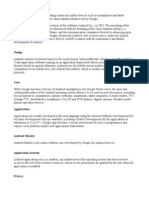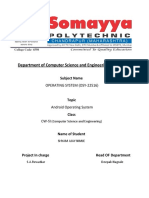0% found this document useful (0 votes)
12 views2 pagesAndroid
Android is a mobile operating system developed by Google, primarily for touchscreen devices, and has become the most widely used OS globally since its launch in 2008. Its open-source nature allows for extensive customization by manufacturers and users, while its integration with Google services and robust development tools make it appealing for app developers. Android's versatility extends beyond smartphones to various devices, including smartwatches and TVs, although security and update consistency remain challenges due to its fragmentation.
Uploaded by
lopybiCopyright
© © All Rights Reserved
We take content rights seriously. If you suspect this is your content, claim it here.
Available Formats
Download as TXT, PDF, TXT or read online on Scribd
0% found this document useful (0 votes)
12 views2 pagesAndroid
Android is a mobile operating system developed by Google, primarily for touchscreen devices, and has become the most widely used OS globally since its launch in 2008. Its open-source nature allows for extensive customization by manufacturers and users, while its integration with Google services and robust development tools make it appealing for app developers. Android's versatility extends beyond smartphones to various devices, including smartwatches and TVs, although security and update consistency remain challenges due to its fragmentation.
Uploaded by
lopybiCopyright
© © All Rights Reserved
We take content rights seriously. If you suspect this is your content, claim it here.
Available Formats
Download as TXT, PDF, TXT or read online on Scribd
/ 2


















































































